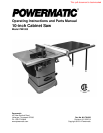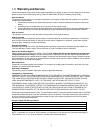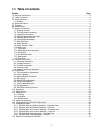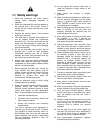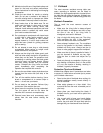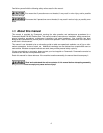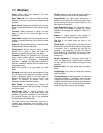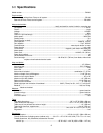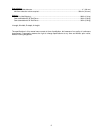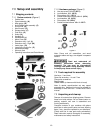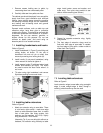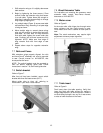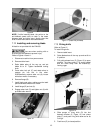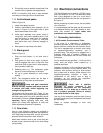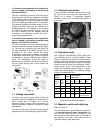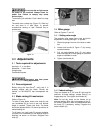5
25. Maintain tools with care. Keep blade sharp and
clean for the best and safest performance.
Follow instructions for lubricating and changing
accessories.
26. Check the saw blade for cracks or missing
teeth. Do not use a cracked or dull blade or
one with missing teeth or improper set. Make
sure the blade is securely locked on the arbor.
27. Keep hands clear of the blade area. Do not
reach past the blade to clear parts or scrap
with the saw blade running. Never saw
freehand. Avoid awkward operations and hand
positions where a sudden slip could cause
your hand to contact the blade.
28. Do not attempt to saw boards with loose knots
or with nails or other foreign material, on its
surface. Do not attempt to saw twisted,
warped, bowed or “in wind” stock unless one
edge has been jointed for guiding purposes
prior to sawing.
29. Do not attempt to saw long or wide boards
unsupported where spring or weight could
cause the board to shift position.
30. Always use the riving knife, blade guard, push
stick and other safety devices for all operations
where they can be used. On operations such
as dadoing or molding where the blade guard
cannot be used, use feather boards, fixtures
and other safety devices and use extreme
caution. Reinstall the riving knife and blade
guard immediately after completing the
operation that required their removal.
31. Be sure the saw blade rotates clockwise when
viewed from the motor side (left side) of the
machine.
32. Turn off the machine before cleaning. Use a
brush or compressed air to remove chips or
debris — do not use your hands.
33. Do not stand on the machine. Serious injury
could occur if the machine tips over.
34. Never leave the machine running unattended.
Turn the power off and do not leave the
machine until it comes to a complete stop.
35. Remove loose items and unnecessary work
pieces from the area before starting the
machine.
3.1 Kickback
The most common accidents among table saw
users, according to statistics, can be linked to
kickback, the high-speed expulsion of material from
the table that can strike the operator. Kickback can
also result in the operator’s hands being pulled into
the blade.
Kickback Prevention
Tips to avoid the most common causes of
kickback:
• Make sure the riving knife is always aligned
with the blade. A workpiece can bind or stop
the flow of the cut if the riving knife is
misaligned, and result in kickback.
• Use a riving knife during every cut. The riving
knife maintains the kerf in the workpiece,
which will reduce the chance of kickback.
• Never attempt freehand cuts. The workpiece
must be fed parallel to the blade, otherwise
kickback will likely occur. Always use the rip
fence or miter gauge to support the workpiece.
• Make sure that rip fence is parallel to blade. If
not, the chances of kickback are very high.
Take the time to check and adjust the rip
fence.
• Feed cuts through to completion. Anytime you
stop feeding a workpiece that is in the middle
of a cut, the chance of binding, resulting in
kickback, is greatly increased.
Protection Tips from Kickback
Kickback can happen even if precautions are taken
to prevent it. Listed below are some tips to protect
you if kickback does occur:
• Stand to the side of the blade when cutting. An
ejected workpiece usually travels directly in
front of the blade.
• Wear safety glasses or a face shield. Your
eyes and face are the most vulnerable part of
your body.
• Never place your hand behind the blade. If
kickback occurs, your hand will be pulled into
the blade.
• Use a push stick to keep your hands farther
away from the moving blade. If a kickback
occurs, the push stick will most likely take the
damage that your hand would have received.



